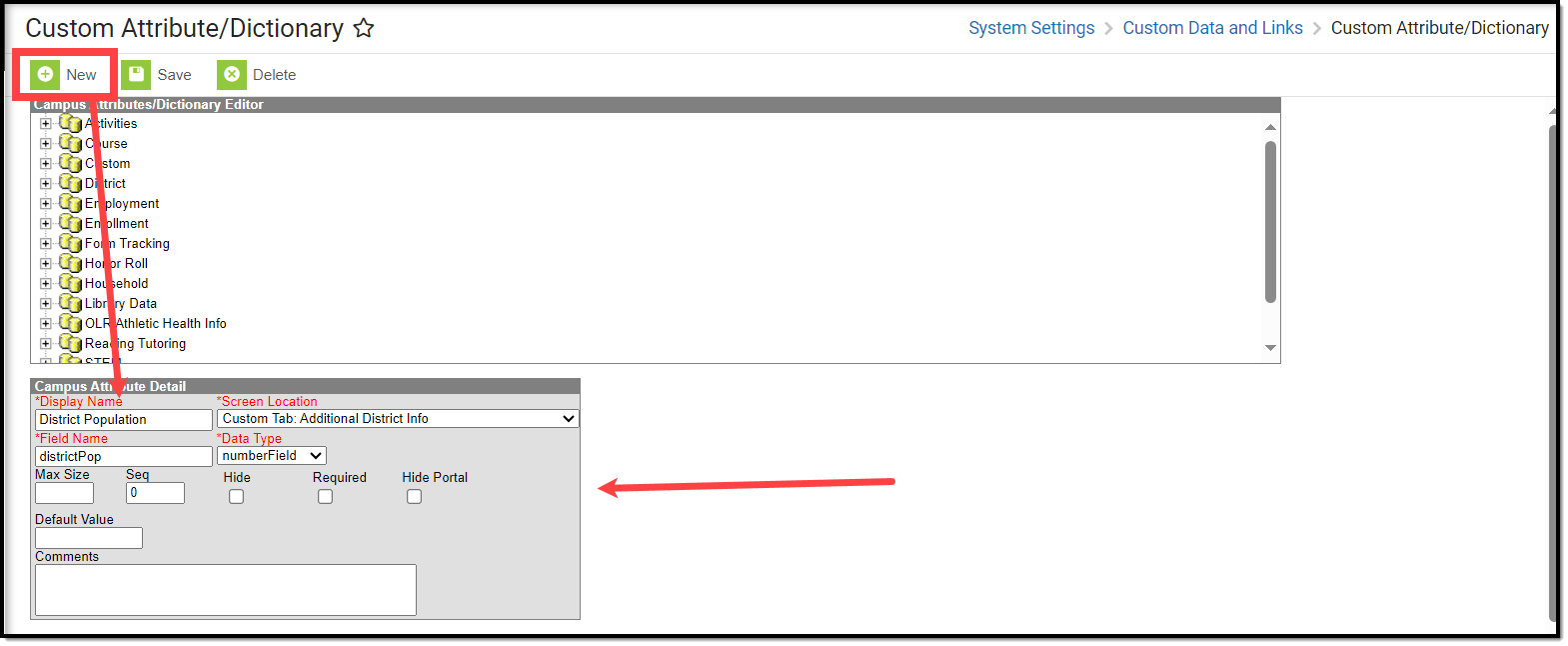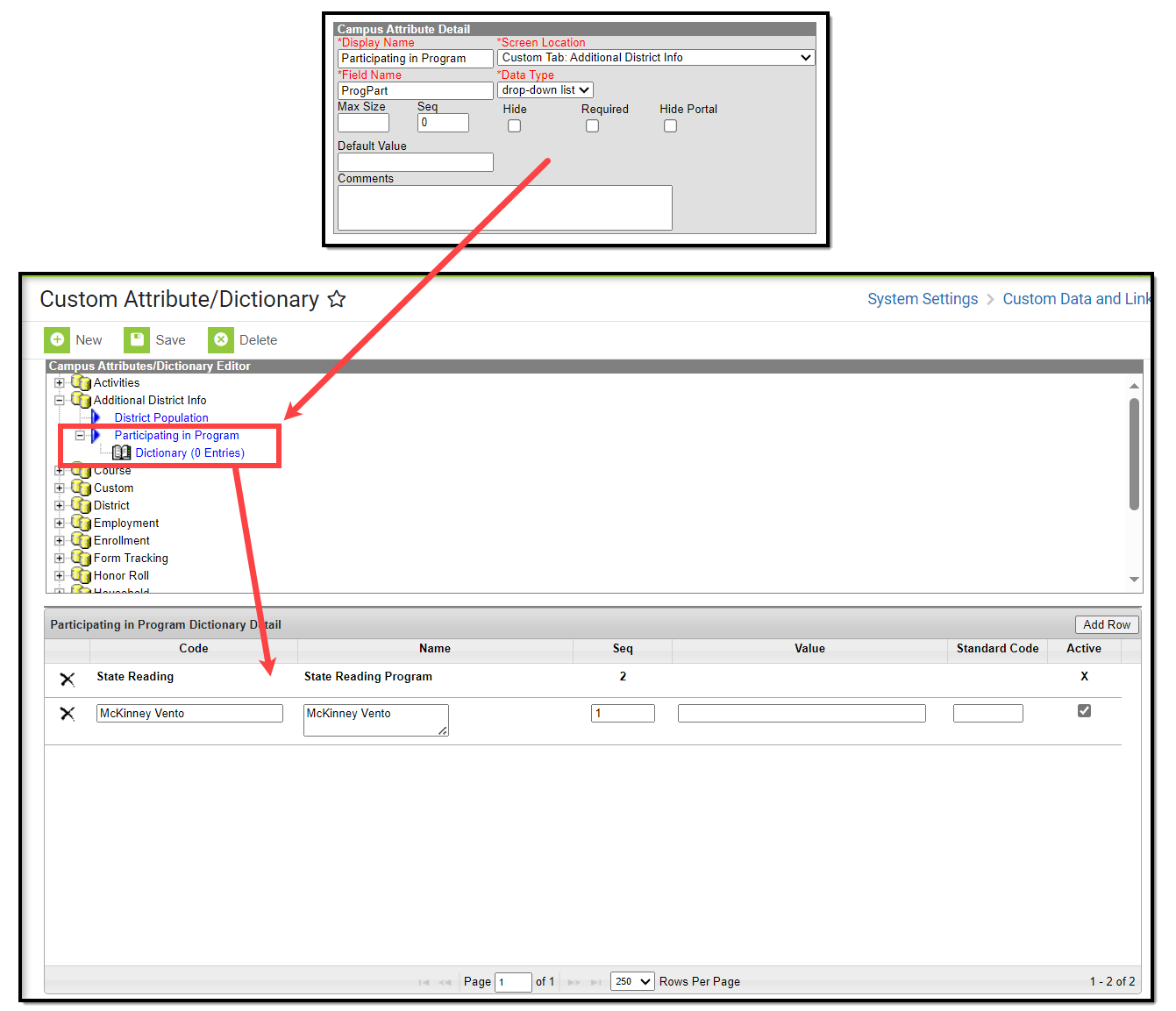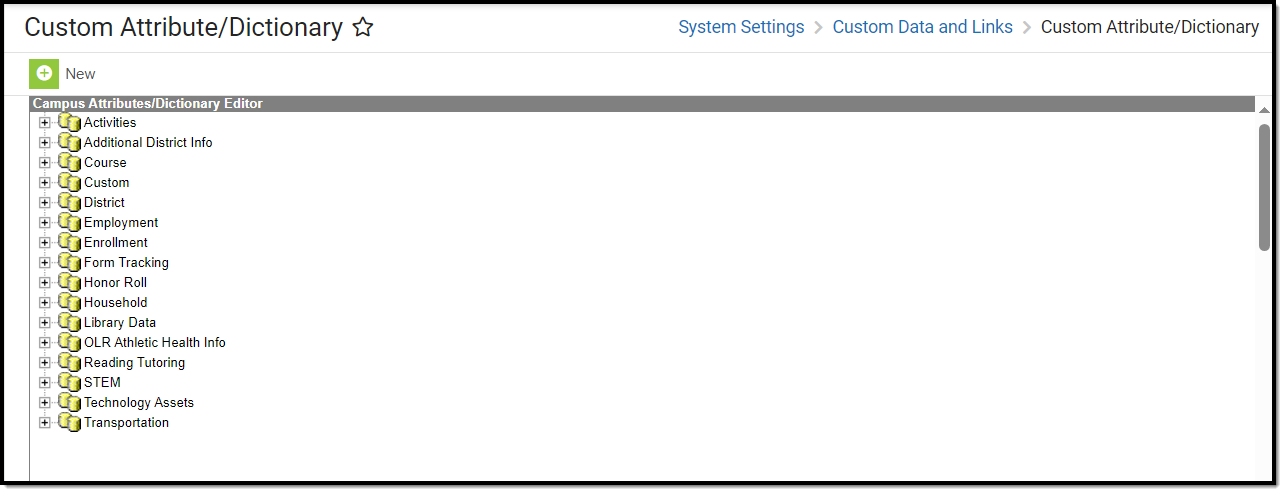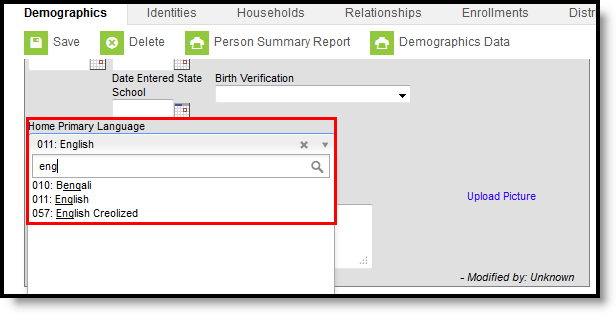Tool Search: Custom Attribute/Dictionary
The Custom Attribute/Dictionary is used to view and create new custom fields for the user interface.
Custom attributes are custom interface fields that can be created at the district/state level for storing localized information not otherwise tracked by an existing Campus field. Custom attributes can be added to certain core tools or to any custom tools created via Custom Tool Setup.
The Custom Attribute tool creates user interface fields that are stored as database attributes within the campusAttribute table.
Information to be contained in a custom field should NOT already have a designated area in the Campus product. Campus recommends conducting a thorough review of existing Campus functionality and schema and/or contacting a Campus Support representative before creating custom fields.
Custom Attributes vs. Attribute/Dictionary
The Custom Attribute tool allows a district/state to view, create, and manage its own localized custom fields.
The purpose of the Attribute Dictionary tool is to view all core elements within the application, organized by state and district. Locally created elements can be created, viewed, and modified in the Custom Attribute tools. Locally created elements are only viewable within the Custom Attribute tool and do not display within the Attribute/Dictionary tool.
Refer to the Custom Data and Links Tool Rights article for details on tool rights for this and related tools.
Create a Custom Field
Note the following:
- Custom fields added to core tools appear in a District Defined Elements editor on the tool.
- If the custom field resides on a custom tool, the custom tool must be created before beginning the following steps.
- Any custom attribute that contains the word "time" cannot be queried in Ad hoc tools if it is not an actual time field.
A custom field contains data not otherwise tracked in Campus. The field's details, format, size, and associated codes/values are configured through this tool.
- Click the New icon. The Campus Attribute Detail editor will appear below.

- Enter the Display Name of the field you would like to add. This is the name that appears in the UI for the field.
- Select the Screen Location. This is where you would select the custom tool you just created. For example, the Additional District Info tool is selected since it was created in the previous steps.
- Enter the Field Name. This is the name used to identify the field in the database.
- Select the Data Type. This determines the type of field presented to users. Refer to the table below for additional information.
Data Type Details textBox Creates a text box.
Users are allowed to enter up to 255 alphanumeric and special characters.
drop-down list Creates a dropdown list.
Limited to 15 alphanumeric characters.dateField Creates a date field.
Users must enter the date in MM/DD/YYYY, MM-DD-YY or MMDDYY format.
numberField Creates a number field.
Only numeric characters (no decimals) are allowed. Max default value is 10.
floatField Creates a float field.
Only numeric characters are allowed with one decimal point.
The max default value is 10. The value can be without a decimal point. If the default value has a decimal, only 2 numbers to the right of the decimal are allowed.timeField Creates a time field.
Users must enter values in HH:MM AM/PM or HH:MM military time. Values should include a semicolon.
ssnField Creates a field for entering a Social Security Number.
Users must enter a number pattern of XXX-XX-XXXX where X = a numeric value between 0-9. Dashes should be included when entering Social Security Numbers. 11 characters total (this includes the dashes between numbers).
phoneField Creates a field for entering phone numbers.
Users should enter phone values in (999)999-9999 or (999)999-9999x9999 format where:
- 9 = a numeric value between 0-9
- x = the delimiter for entering an extension number
emailField Creates a field for entering an email address.
Users must enter email addresses in XXXXX@XXXX.XXX where:- X = any alphanumeric or special characters
- Users may enter multiple periods
- Number of total characters does not surpass 100
- @ is required
moneyField Creates a field for entering a monetary value.
Users must enter a value between 0-9. One decimal point is allowed but only two numbers right of the decimal point are allowed. Values entered can contain the $ special character but is not required.checkBox Creates a checkbox. - Enter any additional information. Refer to the table below for more information on these fields.
Fields Description Default Value The default valuewhich auto-populates in the field when a new record is created.
Note that default values are NOT saved in the database tables.
Max Size The maximum number of characters allowed for entry in the field. Seq The order of the field within the tool.
For example, Field A has a seq of 1 and Field B has a Seq of 2. Field 1 will be listed first followed by Field 2.
If no sequence is indicated, fields display in numeric or alphabetic order.Hide If marked, this custom field will not display within the UI for any users. This is useful for hiding a previously active field from being used. Required If marked, this checkbox indicates the field must be filled out (or checked) for the user to be able to save a record for the custom tool. The field name displays as red text (instead of black) and is followed by an asterisk (*) to indicate that it is required. Copies Forward When marked, the data associated with the attribute is copied forward into the calendar for the next school year.
This option applies to things that are cloned or rolled forward from year to year. For example, calendars are copied from one year to the next, courses are copied forward, and enrollments are copied forward.
People are not tied to a calendar; therefore, attributes associated with people are not copied forward, even when this checkbox is marked.
This option is not available for data fields assigned to a custom tab.
Hide Portal If marked, this checkbox indicates the custom field will not be displayed in the Student or Parent Portal.
This field does not apply or appear to state-level users.
Comments Any comments related to the custom field. These comments do not display for users interacting with the field. - Click Save. The field has now been added to your custom tool.
- If the field you added to your custom tool requires values for selection, such as a dropdown field, locate and select the field in the list at the top of the screen.
For example, in the image below, a dropdown list called Participating in Program was added to the Additional District Info custom tool. The tool was located in the list, and the Dictionary link was selected, opening an editor at the bottom of the screen where field values can be entered.
For more information about custom dropdown lists, refer to the "Custom Dropdown List Fields" section below.
- Enter all required field values, and then click Save once you are finished. Your custom field is now available in the designated tool, and values are available within this field.
- If adding fields to a new custom tool, repeat steps 1-9 until all fields have been added to the tool. Once all fields and field values have been entered, your field(s) are ready to start collecting data.
Custom Tools and Custom Attributes
Custom Tool Setup allows you to create custom tools for tracking local or state-level information. You can also use this tool to embed hyperlinks to appear as a tool within the Infinite Campus navigation and have these links open in a new tab or within the workspace. When a custom tool is created, it still requires custom attributes to be defined, as these are the custom fields and field values that will populate the custom tool. The easiest way to think of this is:
- The custom tool is created via Custom Tool Setup.
- Once created, you need to use the Custom Attribute/Dictionary to create the fields and field values that will appear in this tool.
- Once the custom tool has been created and fields added, district users can begin entering data and creating new records in this tool.
For a step-by-step walkthrough of this process, please see the Custom Tool Setup article.
Custom Fields (Database-Only)
The following fields of the campusAttribute table relate to creating/modifying custom fields. These fields are only available in the database; they do not appear in the user interface. This is not a complete list of database fields.
Database Column | Description |
|---|---|
attributeID | Internal database identifier used as a reference in other tables. |
coreLock | This column no longer impacts the function of an attribute. Controls whether a user may modify the settings of an attribute field through the user interface.
|
custom | Indicates whether the attribute was created by a Campus user or is a core field. |
dated | Retains historical information of custom fields by setting the date on each entry and creating a new entry for each change. |
lock | Controls whether a user may add/change/delete dictionary values (codes) for the custom attributes within the user interface. |
statusData | Controls whether the values of the custom field are stored in one of the custom tables named as “custom” followed by the object (e.g., customStudent). This flag and the stateTable flag are mutually exclusive. Only one should be set at a time. |
stateTable | Controls whether or not values of the custom field are stored in a state-specific table named as the custom object followed by the state abbreviation appended (e.g., EnrollmentME). This flag and the statusData flag are mutually exclusive. Only one should be set at a time. |
Custom Dropdown List Fields
The following fields are displayed in the Dictionary Detail editor when creating codes/values associated with a custom dropdown list field in the user interface. This data is stored in the campusDictionary table.
Field | Description | Database Location |
|---|---|---|
Code | An abbreviated version of the value that displays directly before the value entered in the Name field when displayed for selection within the custom field. | CampusDictionary. |
Name | Text descriptor of the code value as it should display in the custom field dropdown list. This directly follows the value entered in the Code field when displayed for selection within the custom field. | CampusDictionary. |
Seq | The order of the custom field on the tab, as related to the other fields on the tab. | CampusDictionary. |
Value | Used to store additional, localized data related to the value (mapping a local value to state values) and/or for state-reporting purposes. This text is not displayed to end users as part of the visible dropdown list value. | CampusDictionary. |
StandardCode | Used for SIF naming purposes. This text is not displayed to end users as part of the visible dropdown list value. | CampusDictionary. |
Active | If marked, the checkbox indicates the value should be actively available for selection from the dropdown custom field to which it is assigned. If this checkbox is not marked, the dictionary item does not display in the dropdown field. | CampusDictionary. |
Database-Only Fields The following fields of the campusDictionary table relate to creating codes/values for custom dropdown list fields. These fields are only available in the database; they do not appear in the user interface. | ||
| dictionaryID | Internal database identifier that can be referenced by other tables. | |
| attributeID | Internal database identifier – foreign key from the campusAttribute table. | |
When the total number of dictionary items is greater than or equal to 50, the dropdown list on the tool becomes an auto-search field, allowing the user to type the first few letters of the item and the available choices filter to those matching the entered text.
Sorting Logic
Depending on the type of Data Type selected for a Custom Attribute, the attributes assigned to that data type sort differently.
| Data Type | Sorting Hierarchy |
|---|---|
| Single Screen Editor |
|
| Table Editor |
|
| Dropdown Lists |
|
| List Editor |
|
When these custom tabs/attributes are available on the Campus Portal, the following hierarchy applies.
| Data Type | Sorting Hierarchy |
|---|---|
| Single Screen Editor |
|
| List Editor |
|
| Table Editor |
|




